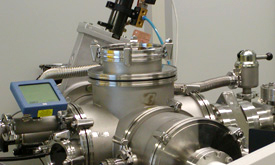The technology development was performed on a single layered gradiometric sensor design.
The modification of a variety of deposition and pattern transfer techniques in combination with an adequate lithography led to an optimisation of the production process yield. This was especially neccessary with regard to an economic utilisation of the technology.
The carrier material is a MgO-bicrystal substrate. Pulse Laser Deposition (PLD) is used to deposit the superconducting layer of YBCO. After the identification and marking of the grain boundary the bicrystal and the sensor structure are adjusted.
After the chip is processed it is places inside a special glassfiber encapsulation and arranged as an integrated coil configuration.
At last the whole setup is sealed and the sensor is tested and characterised.
Application
The SQUID gradiometer with integrated compensation of homogeneous fields is perfectly suited for measurements of small magnetic field gradients within strong magnetic field environments such as the Earth magnetic field. The gradiometric setup can be arbitrarily moved in the Earth magnetic field without influencing the sensor´s function.
Possible applications for the HTS SQUID gradiometer are non-destructive material testing, biomagnetic, geomagnetic and archaeological measurements.

